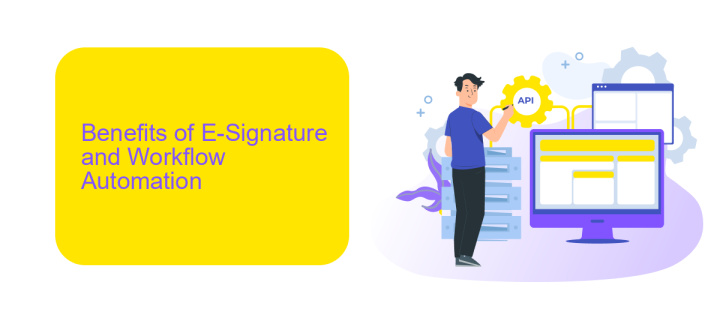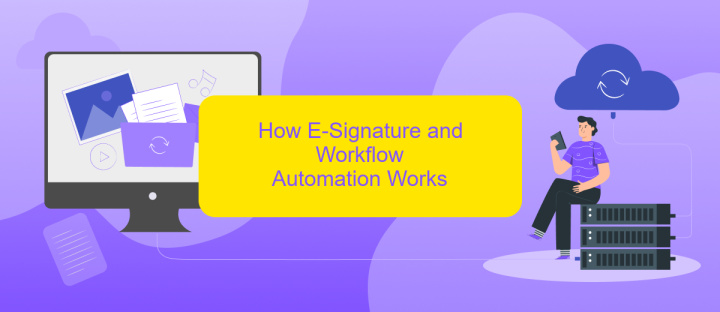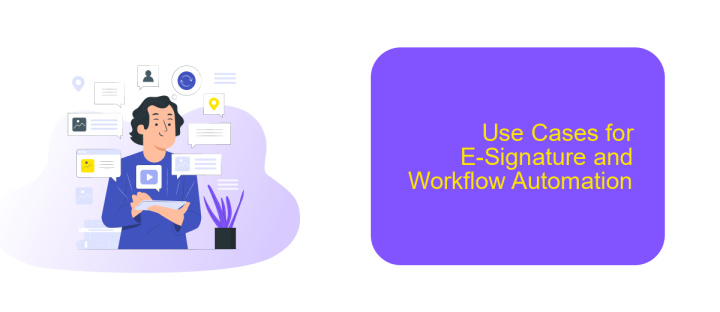E Signature and Workflow Automation
In today's fast-paced digital world, e-signature and workflow automation have become essential tools for businesses seeking efficiency and security. By streamlining document approval processes and reducing manual tasks, these technologies not only save time but also enhance accuracy and compliance. Discover how integrating e-signature and workflow automation can transform your business operations and drive productivity to new heights.
Introduction
In today's fast-paced business environment, the need for efficient and secure methods to manage documents and workflows has never been greater. E-signature technology and workflow automation are revolutionizing the way organizations operate, providing a seamless and paperless solution to traditional processes.
- Enhanced security and compliance
- Improved efficiency and productivity
- Reduced operational costs
- Streamlined document management
Integrating e-signatures and workflow automation into your business processes can be simplified with tools like ApiX-Drive. This platform enables seamless integration of various services and applications, ensuring that your digital workflows are both efficient and reliable. By leveraging such technologies, businesses can stay competitive and adapt to the ever-evolving digital landscape.
Benefits of E-Signature and Workflow Automation

E-signature and workflow automation provide numerous benefits, streamlining business processes and enhancing efficiency. By replacing traditional paper-based signatures with electronic ones, organizations can significantly reduce turnaround times and operational costs. This digital transformation not only speeds up document approvals but also ensures higher accuracy and security, as e-signatures are often encrypted and legally binding. Additionally, automated workflows eliminate the bottlenecks associated with manual processes, allowing for a smoother and more consistent flow of tasks.
Integrating e-signature solutions with workflow automation tools can further amplify these advantages. For instance, using services like ApiX-Drive, businesses can effortlessly connect various applications and automate data transfer between them. This integration minimizes human error and ensures that all necessary documents are signed and processed without delay. Consequently, companies can focus more on strategic initiatives rather than getting bogged down by administrative tasks, leading to increased productivity and improved overall performance.
How E-Signature and Workflow Automation Works

E-signature and workflow automation streamline business processes by digitizing document signing and automating repetitive tasks. This combination enhances efficiency, reduces human error, and ensures compliance with legal standards.
- Document Creation: Users create or upload documents that require signatures.
- Signature Request: The system sends out requests for e-signatures to the relevant parties.
- Signature Collection: Recipients sign the document electronically via a secure platform.
- Workflow Automation: The signed document triggers subsequent automated tasks, such as notifications, data entry, or file storage.
- Integration: Services like ApiX-Drive can be used to integrate various applications, ensuring seamless data flow and task automation across different platforms.
Utilizing e-signature and workflow automation not only accelerates the signing process but also ensures that all steps are tracked and documented. This integration, especially with tools like ApiX-Drive, allows businesses to maintain a high level of operational efficiency and accuracy, leading to improved productivity and reduced operational costs.
Use Cases for E-Signature and Workflow Automation

E-signature and workflow automation have revolutionized how businesses handle documentation and streamline processes. By integrating these technologies, companies can achieve significant improvements in efficiency, compliance, and cost savings.
One of the primary use cases for e-signature and workflow automation is in contract management. Automating the signing process reduces the time it takes to finalize agreements and ensures that all documents are securely stored and easily accessible. Another common application is in human resources, where e-signatures can expedite the onboarding process for new employees and streamline the approval of leave requests and other HR documents.
- Contract Management: Speed up the signing process and ensure secure document storage.
- Human Resources: Expedite onboarding and streamline document approvals.
- Finance: Automate invoice approvals and financial reporting.
- Legal: Ensure compliance and secure handling of legal documents.
- Sales: Accelerate deal closures with quick and easy e-signatures.
For businesses looking to integrate e-signature and workflow automation seamlessly, services like ApiX-Drive can be invaluable. ApiX-Drive enables easy integration of various applications, ensuring that e-signature tools work harmoniously with existing systems, thereby enhancing productivity and reducing manual errors.
- Automate the work of an online store or landing
- Empower through integration
- Don't spend money on programmers and integrators
- Save time by automating routine tasks
Implementation and Best Practices
Implementing e-signature and workflow automation requires a strategic approach to ensure seamless integration and maximum efficiency. Begin by selecting a robust e-signature solution that aligns with your organizational needs. Ensure that the chosen platform complies with industry standards and regulations such as eIDAS or ESIGN Act. Integrate the e-signature tool with your existing systems, such as CRM or document management software, to streamline processes and reduce manual tasks. Utilize services like ApiX-Drive to facilitate these integrations, allowing for automated data transfer and synchronization across platforms.
Adopting best practices is crucial for successful implementation. Train your team thoroughly on the new tools and workflows to minimize resistance and promote adoption. Establish clear guidelines and protocols for using e-signatures to maintain consistency and security. Regularly review and optimize your automated workflows to identify areas for improvement and ensure they remain aligned with your business objectives. By continuously refining your processes and leveraging integration services like ApiX-Drive, you can enhance productivity and maintain a competitive edge in your industry.
FAQ
What is an e-signature and how does it work?
Are e-signatures legally binding?
How can I automate my workflow with e-signatures?
What are the benefits of using e-signatures in workflow automation?
How can I integrate e-signatures into my existing systems?
Apix-Drive is a simple and efficient system connector that will help you automate routine tasks and optimize business processes. You can save time and money, direct these resources to more important purposes. Test ApiX-Drive and make sure that this tool will relieve your employees and after 5 minutes of settings your business will start working faster.


